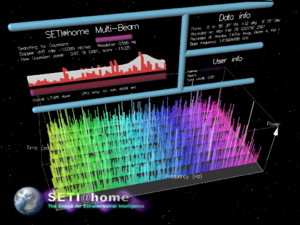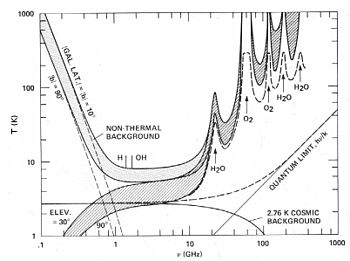User:Johndhs//Setiathome/sandbox

The search for extraterrestrial intelligence (SETI) is the collective name for a number of activities undertaken to search for intelligent extraterrestrial life. SETI projects use scientific methods in this search. For example, electromagnetic radiation is monitored for signs of transmissions from civilizations on other worlds.[1][2] Some of the most well-known projects are run by Harvard University, the University of California, Berkeley, or the SETI Institute. In 1995, the United States federal government ceased funding to SETI projects, forcing them to turn to private funding to continue the search, though in recent years, government funding of SETI has resumed at modest levels.[3]
There are great challenges in searching the cosmos for signs of intelligent life, including their identification and interpretation. SETI projects use the best available scientific knowledge to conduct experiments, which has traditionally led to searches for electromagnetic radiation emitted by advanced technologies.
Radio experiments[edit]

Many radio frequencies penetrate Earth's atmosphere quite well, and this led to radio telescopes that investigate the cosmos using large radio antennas. Furthermore, human endeavors emit considerable electromagnetic radiation as a byproduct of communications such as television and radio. These signals would be easy to recognize as artificial due to their repetitive nature and narrow bandwidths. If this is typical, one way of discovering an extraterrestrial civilization might be to detect non-natural radio emissions from a location outside the Solar System.
Early work[edit]
As early as 1896, Nikola Tesla suggested that an extreme version of his wireless electrical transmission system could be used to contact beings on Mars.[4] In 1899 while investigating atmospheric electricity using a Tesla coil receiver in his Knob Hill lab, Tesla observed repetitive signals, substantially different from the signals noted from storms and Earth noise, that he interpreted as being of extraterrestrial origin. He later recalled the signals appeared in groups of one, two, three, and four clicks together. Tesla thought the signals were coming from Mars. Analysis of Tesla's research has ranged from suggestions that Tesla detected nothing, he simply was misunderstanding the new technology he was working with,[5] to claims that Tesla may have been observing naturally occurring Jovian plasma torus signals. In the early 1900s, Guglielmo Marconi, Lord Kelvin, and David Peck Todd also stated their belief that radio could be used to contact Martians, with Marconi stating that his stations had also picked up potential Martian signals.[6]
On August 21–23, 1924, Mars entered an opposition closer to Earth than any time in a century before or the next 80 years.<ref>{{cite web |url=http://www.imcce.fr/Equipes/ASD/mars/oppo_en.html |title=A Primer on Mars Oppositions |author=Jacques
- ^ Schenkel, Peter (May 2006). "SETI Requires a Skeptical Reappraisal". Skeptical Inquirer. Retrieved June 28, 2009.
- ^ Moldwin, Mark (November 2004). "Why SETI is science and UFOlogy is not". Skeptical Inquirer.
- ^ "ROSES 2011 Grant Awards". NASA. May 2006. Retrieved July 12, 2013.
- ^ Seifer, Marc J. (1996). "Martian Fever (1895–1896)". Wizard : the life and times of Nikola Tesla: biography of a genius. Secaucus, New Jersey: Carol Pub. p. 157. ISBN 978-1-55972-329-9. OCLC 33865102.
- ^ Spencer, John (1991). The UFO Encyclopedia. New York: Avon Books. ISBN 978-0-380-76887-5. OCLC 26211869.
- ^ Corum, Kenneth L.; James F. Corum (1996). Nikola Tesla and the electrical signals of planetary origin (PDF). pp. 1, 6, 14. OCLC 68193760.
